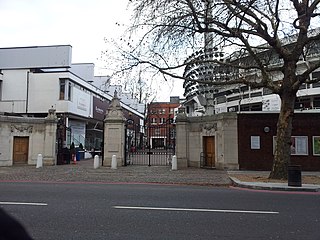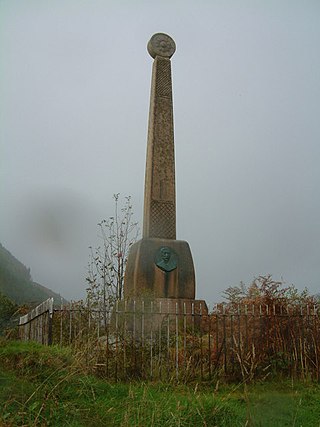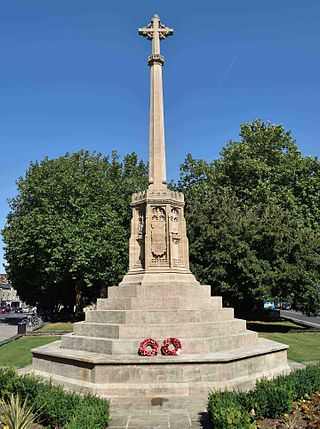The Peace Tower is a focal bell and clock tower sitting on the central axis of the Centre Block of the Canadian parliament buildings in Ottawa, Ontario. The present incarnation replaced the 55-metre (180 ft) Victoria Tower, after the latter burned down in 1916, along with most of the Centre Block; only the Library of Parliament survived. It serves as a Canadian icon and had been featured prominently on the Canadian twenty-dollar bill, directly adjacent to the depiction of Queen Elizabeth II, until the change to polymer.

Sir William Goscombe John was a prolific Welsh sculptor known for his many public memorials. As a sculptor, John developed a distinctive style of his own while respecting classical traditions and forms of sculpture. He gained national attention with statues of eminent Victorians in London and Cardiff and subsequently, after both the Second Boer War and World War I, created a large number of war memorials. These included the two large group works, The Response 1914 in Newcastle upon Tyne and the Port Sunlight War Memorial which are considered the finest sculptural ensembles on any British monument.

The Welsh National War Memorial is situated in Alexandra Gardens, Cathays Park, Cardiff. The memorial was designed by Sir Ninian Comper and unveiled on 12 June 1928 by the Prince of Wales. The memorial commemorates the servicemen who died during the First World War and has a commemorative plaque for those who died during the Second World War, added in 1949.

The Royal Air Force Memorial is a military memorial on the Victoria Embankment in central London, dedicated to the memory of the casualties of the Royal Air Force in World War I. Unveiled in 1923, it became a Grade II listed structure in 1958, and was upgraded to Grade II* in 2018. It is considered to be the official memorial of the RAF and related services.
Edward Alfred Briscoe Drury was a British architectural sculptor and artist active in the New Sculpture movement. During a long career Drury created a great number of decorative figures such as busts and statuettes plus larger monuments, war memorials, statues of royalty and architectural pieces. During the opening years of the 20th-century he was among the foremost architectural sculptors active in Britain and in that period created the series of works in central London for which he is perhaps now best known. These include the figures on the Old War Office building in Whitehall, elements of the facade of the Victoria and Albert Museum and four of the colossal statues on Vauxhall Bridge.

The South African War Memorial is an equestrian memorial dedicated to the South Australians who served in the Second Boer War of 11 October 1899 to 31 May 1902. It was the first war in which South Australians fought, and 1531 men were sent in nine contingents, with over 1500 horses to accompany them. Over 59 South Australians died in the war.

William Robert Colton was a British sculptor. After completing his studies in London and Paris, Colton established himself with solid, career-long business relationships, secured admission to exhibitions at the Royal Academy and the Salon in Paris. His works included commissions for busts, statues and war memorials. His clientele included royalty in England and India.

St German's Church is a nineteenth-century Church in Wales parish church in Adamsdown, Cardiff, Wales dedicated to St Germanus of Auxerre,. The building, located on the corner of Star Street and Metal Street, is a Grade I Listed building.

The Grace Gates, officially the W. G. Grace Memorial Gates, are two pairs of gates on St John's Wood Road at Lord's Cricket Ground in London, England. They were erected in 1923 and the gates with their flanking walls and piers became a Grade II listed building in 1996.

The Boer War Memorial stands in the shopping precinct of Winsford, Cheshire, England. It consists of the statue of a soldier in uniform standing on a plinth, and it was unveiled in 1906. It originally stood on a different site in the town and was moved to its present position in the 1960s. In addition to recording the names of those who were lost in the conflict, it also contains the names of those who survived.

The Cavalry of the Empire Memorial, also known as the Cavalry Memorial, is a war memorial in Hyde Park, London. It commemorates the service of cavalry regiments in the First and Second World Wars. It became a Grade II listed building in 1987, and was promoted to Grade II* in November 2014.

Lewes War Memorial is a war memorial at the top of School Hill in the centre of Lewes in East Sussex, prominently sited at the junction of High Street and Market Street. It commemorates 251 men from Lewes who died in the First World War, and 126 who died in the Second World War. It was unveiled in 1922 and became a listed building in 1985.

St Saviour's War Memorial is a war memorial on Borough High Street, in the former parish of Southwark St Saviour, to south of the River Thames in London. It became a Grade II listed building in 1998 and was upgraded to Grade II* in 2018.

The Royal Artillery Boer War Memorial is located on the south side of The Mall in Central London, close to the junction with Horse Guards Road at the northeast corner of St James's Park. Unveiled in 1910, it marks the deaths of the 1,083 soldiers of the Royal Artillery who died in the Second Boer War from 1899 to 1902 It has been a listed building since 1970.

The Winchester College War Cloister is a war memorial at Winchester College, in Hampshire, designed by the architect Sir Herbert Baker. The roofed quadrangle is said by Historic England to be the largest known private war memorial in Europe. It became a Grade II listed building in 1950, and was upgraded to Grade I in 2017, as one of 24 war memorials in England designed by Baker that were designated by Historic England as a national collection.

The Hughes Memorial in Corris is a memorial obelisk commemorating Alfred W. Hughes, who served as a surgeon in the Second Boer War. Hughes died of fever in South Africa in 1900. In 2013, Professor Chris Williams of Swansea University described it as one of the most important objects in Welsh history.

Twickenham War Memorial, in Radnor Gardens, Twickenham, London, commemorates the men of the district of Twickenham who died in the First World War. After 1945, the memorial was updated to recognise casualties from the Second World War. The memorial was commissioned by Twickenham Urban District Council in 1921. It was designed by the sculptor Mortimer Brown, and is Brown's only significant public work. The memorial is unusual for its representation of a jubilant soldier returning home. It became a Grade II* listed structure in 2017.

Swansea War Memorial, also known as Swansea Cenotaph, is a war memorial on the promenade beside Mumbles Road, the A4067, near Brynmill to the southwest of Swansea city centre, overlooking Swansea Beach and Swansea Bay.

Oxford War Memorial is a first world war memorial in Oxford, at the north end of St Giles', on the junction where the road splits into the A4144 Woodstock Road and the A4165 Banbury Road. The memorial stands in St Giles Memorial Garden, about 150 m (490 ft) to the south of St Giles' Church, Oxford. It was unveiled in 1921 and became a Grade II listed structure in 2016. The Grade II* listed Martyrs' Monument stands about 350 m (1,150 ft) south, at the other end of St Giles'.

The Worcester Boer War Memorial in Worcester, England, was unveiled near Worcester Cathedral in 1908. The war memorial commemorates casualties of the Second Boer War from the county of Worcestershire. It was designated a Grade II* listed building in 1999.

























